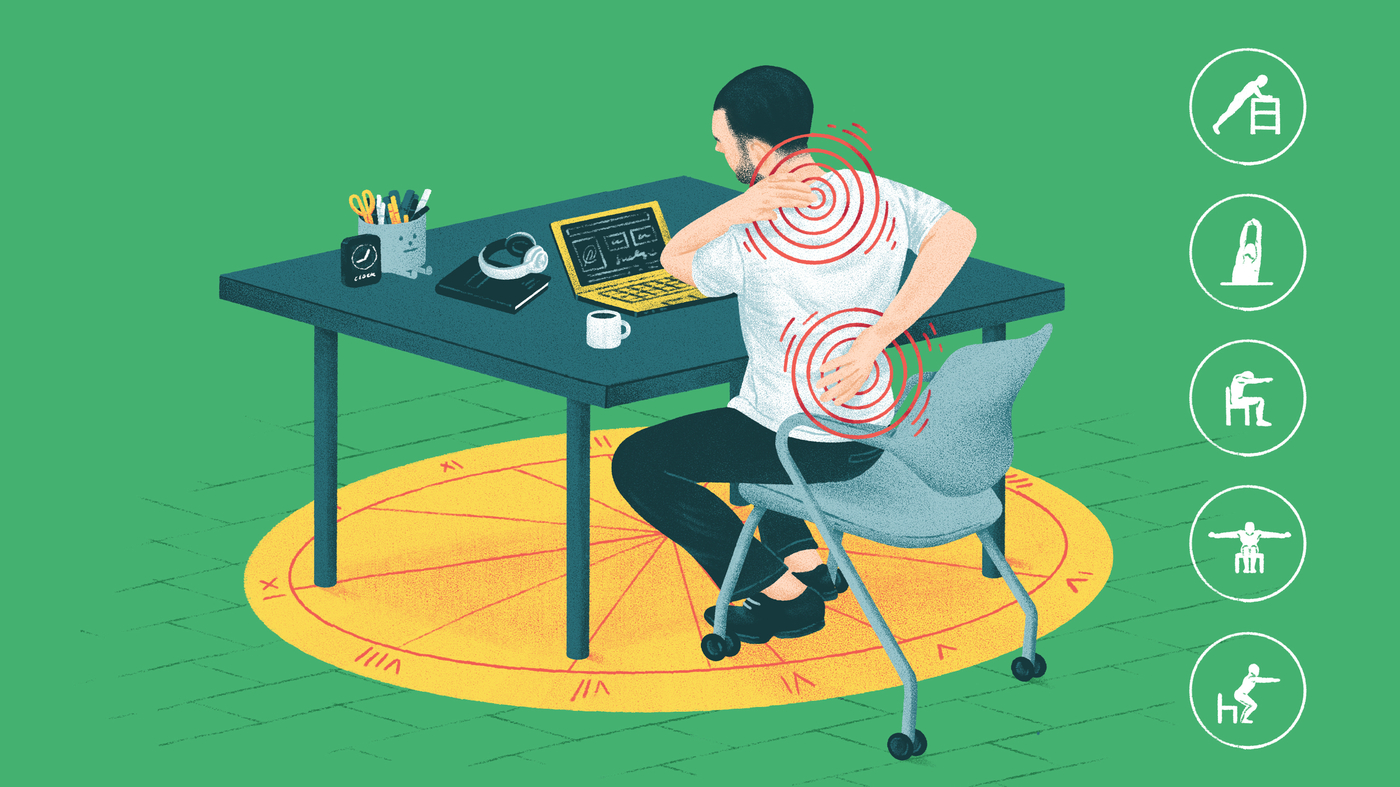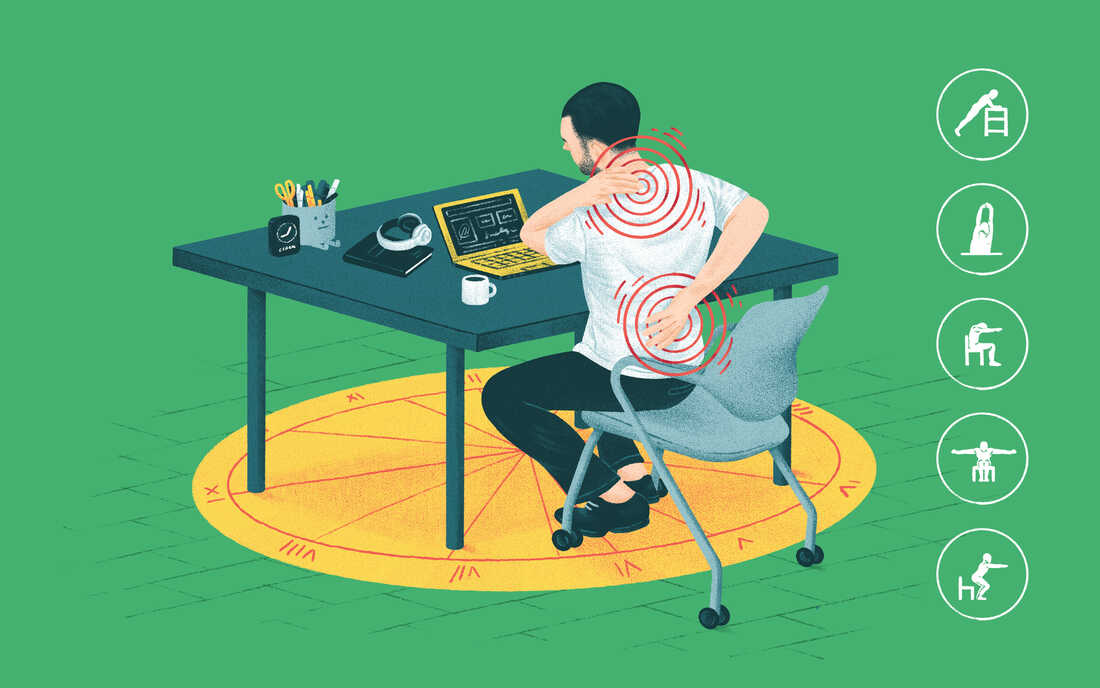
Back and neck pain from screen use are common. Researchers say breaking up the work day with little bursts of exercise can help.
Cha Pornea for NPR
hide caption
toggle caption
Cha Pornea for NPR

Back and neck pain from screen use are common. Researchers say breaking up the work day with little bursts of exercise can help.
Cha Pornea for NPR
After staring at a computer screen for hours at a time, the body often gives us a clue that it is stressed: nagging neck and back pain.
To fix the problem, you might have gotten advice to focus on posture or ergonomics, but exercise research points to another strategy as well – taking short spurts of movement throughout the day to release tension and stress in the body.
“As a society, the assumption is that we have pain because of poor posture and slouching,” says Kieran O’Sullivan, an associate professor of physiotherapy at the University of Limerick’s School of Allied Health in Ireland. “But [the issue] isn’t as neat and tidy as we thought. We have been trying all these fixes [with ergonomics] and it has arguably not fixed the problem. I think it is more about needing breaks from the working day with … movement.”
Here’s how researchers think quick hits of movement – sometimes called exercise “snacks” – may help prevent pain. When the brain senses physical or emotional stress, the body releases hormones that trigger muscles to become guarded and tight. Exercise counters that stress response by increasing blood flow to muscles, tendons and ligaments and sending nutrients to the spine’s joints and discs.
Fitness specialists at NASA, an agency where people work in high-stress seated positions, developed a set of 20 one-minute exercises to prevent pain that anyone can do at their desk. We’ve chosen five here for you to try.

Standing Desk Plank: Place your forearms on the desk, hands touching. Extend your legs with toes on the floor. Contract your abdominal muscles. Maintain a straight line from head to toes without lifting or sinking your hips. Hold for 10–15 seconds. Rest and repeat.
Cha Pornea for NPR
hide caption
toggle caption
Cha Pornea for NPR
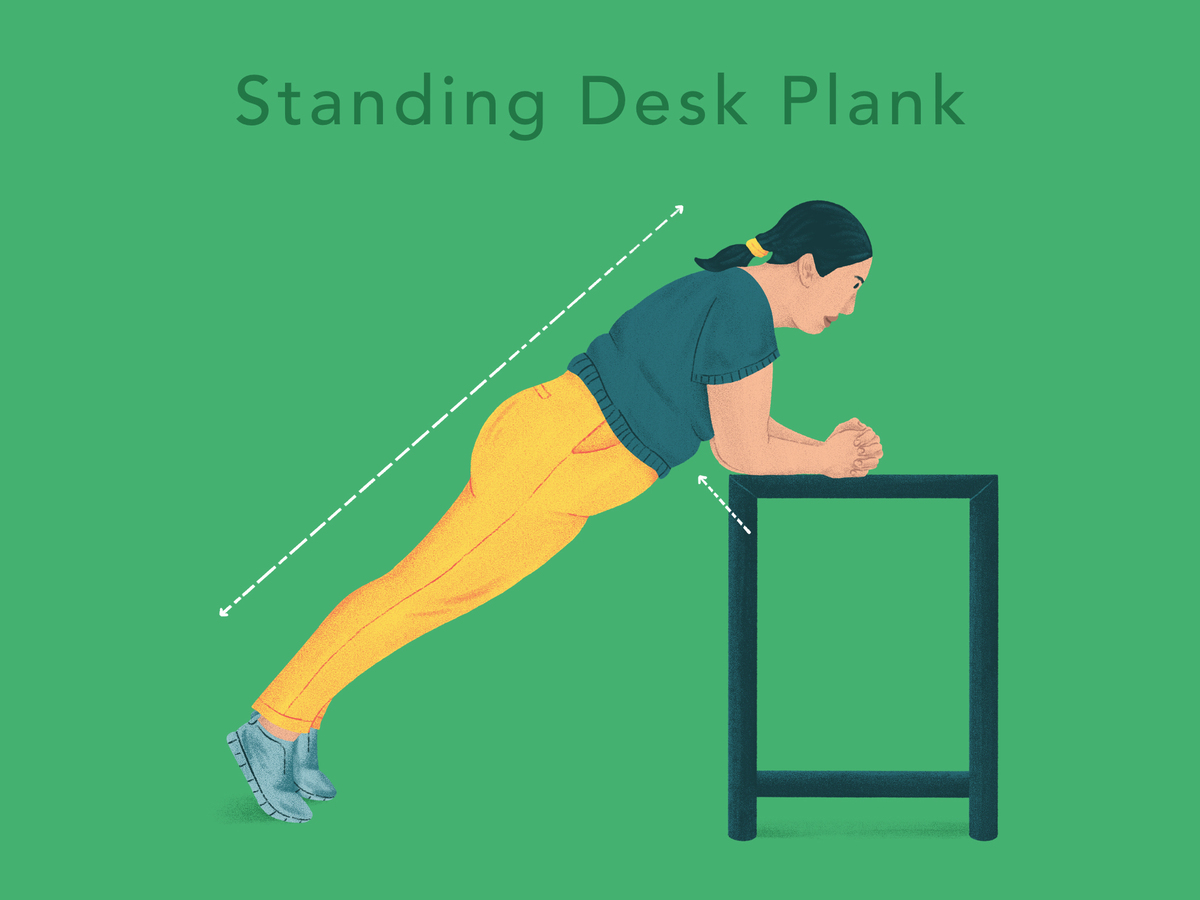
Standing Desk Plank: Place your forearms on the desk, hands touching. Extend your legs with toes on the floor. Contract your abdominal muscles. Maintain a straight line from head to toes without lifting or sinking your hips. Hold for 10–15 seconds. Rest and repeat.
Cha Pornea for NPR
Movement is also hydrating for connective tissues and joints, reversing the stiffening that arises with too much sedentary behavior, says Dr. Helene Langevin, director of the National Institute of Health’s National Center for Complementary and Integrative Health, which recently funded more than a half-dozen studies on connective tissue and pain.
“Taking small breaks and moving around throughout the day…prevents your body from ‘congealing,'” Langevin says.
Movement snacks can also have broader health benefits. Brief bouts of movement, from gentle to vigorous, repeated several times a day, can improve cardiovascular health, halt muscle loss, reduce all-cause mortality, and reduce stress, physiology and movement experts say, citing a growing body of medical studies.
Stretch, flex or even fidget
Any kind of movement works – from yoga poses to walking briskly around the room or running up several flights of stairs.
The NASA program included seated marches, standing calf raises, push-ups with hands on the desk, standing leg curls and neck, shoulder, and back stretches.
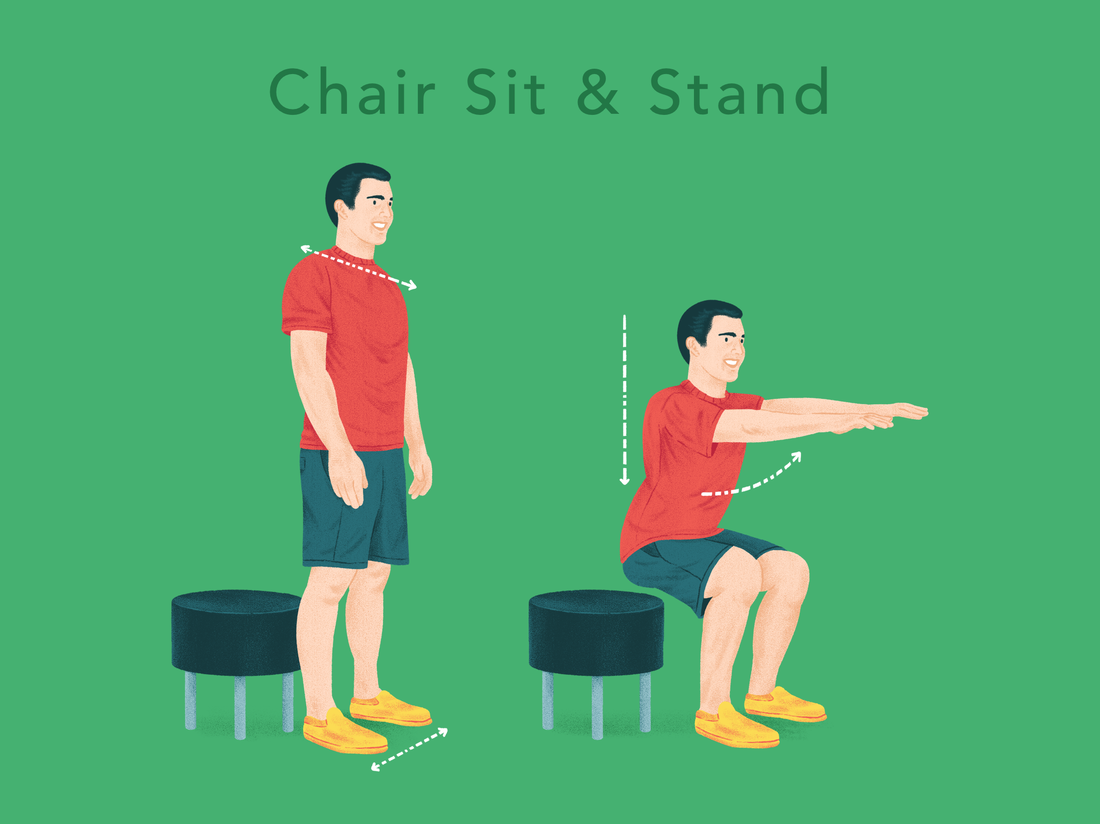
Chair Sit & Stand: Stand in front of a chair with your legs shoulder-width apart. Squat down like you are sitting on the chair but without actually touching it. Maintain a straight back, keeping knees above the feet, weight on the heels. Straighten your legs to return to the starting position. Repeat 10–15 times.
Cha Pornea for NPR
hide caption
toggle caption
Cha Pornea for NPR
“Your body is always talking to you,” said Marceleus M. Venable, a personal trainer in Washington D.C.. and co-author of the NASA exercise program. “Your hands cramp, you have hip pain and neck pain … it’s saying: ‘hey, can you stretch me?’
No one set of exercises works for every body. Rather, people should focus on movements that challenge areas of weakness, strengthen multiple parts of the body at once and that they enjoy, says Katy Bowman, a Carlsborg, Wash., biomechanist and author of the book Move Your DNA.
“It’s not as simple as, everyone with back pain, do these four [abdominal] moves,” says Bowman. “It’s just like dietary nutrition. Just as you need a spectrum of dietary nutrients, you need a spectrum of movements that make the body strong from head to toe.”
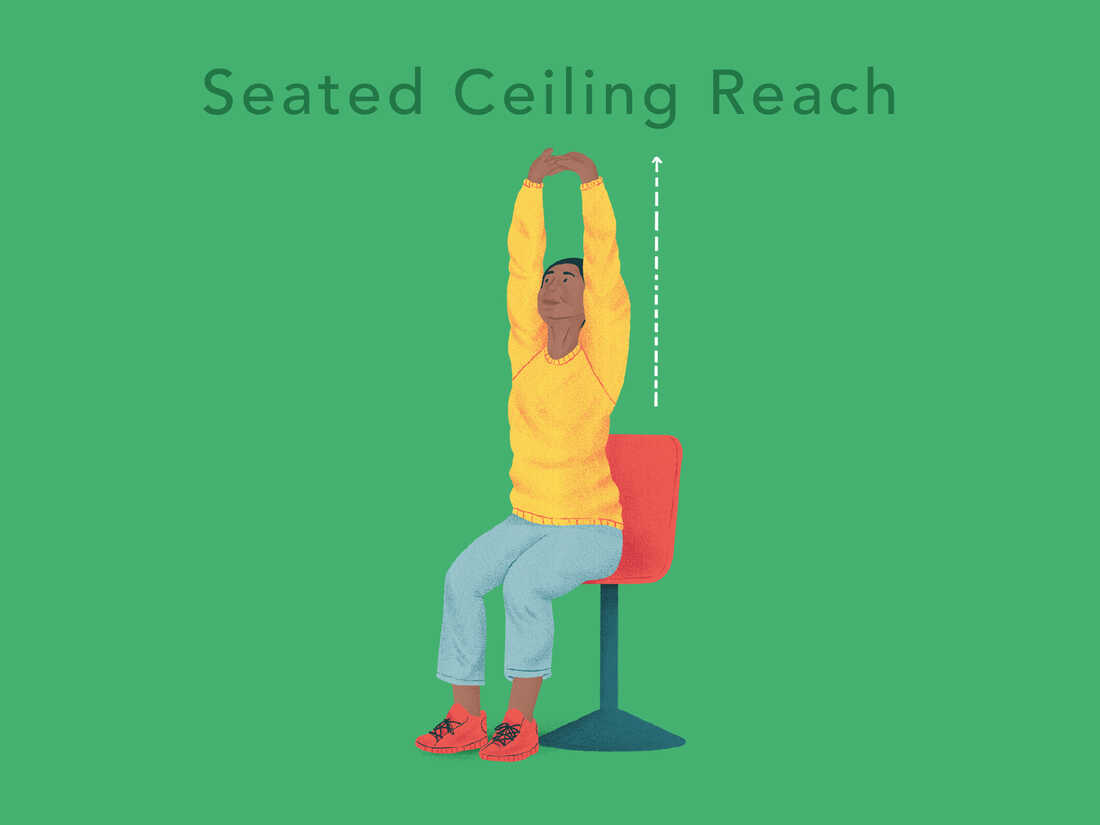
Seated Ceiling Reach: Clasp your hands together above your head with your palms facing up toward the ceiling. Push your arms up, stretching upward. Hold this stretch for 10–15 seconds while taking deep breaths. Perform at least two sets.
Cha Pornea for NPR
hide caption
toggle caption
Cha Pornea for NPR

Seated Ceiling Reach: Clasp your hands together above your head with your palms facing up toward the ceiling. Push your arms up, stretching upward. Hold this stretch for 10–15 seconds while taking deep breaths. Perform at least two sets.
Cha Pornea for NPR
Bowman advises setting a timer for every half hour or hour, and then doing anything you can to change up the positioning of the body. Make movements that will vary loads placed on the spine and muscles. For example, if you had your hands at the keyboard for a while, take a minute to reach the arms over the head and stretch. Then stand up and take the spine through its ranges of motion: forward and back, side to side and rotations left to right.
“I’m a big advocate of fidgeting,” she says. “Keep repositioning yourself — you can’t really sit and not move for hours and hours a day and expect your body to be happy with that.”
Active breaks may help with pain
A large-scale study of Denmark’s workforce health promotion programs found those who took activity breaks, compared to those who did nothing, were less likely to need multiple sick days from illness and pain.

Seated Reverse Shoulder Fly: Sit on the edge of the chair and lean forward while keeping your lower back naturally arched. Your palms should be facing each other. Raise your arms straight out from your sides. Pause and then slowly return to the starting position. Repeat the exercise 15 times.
Cha Pornea for NPR
hide caption
toggle caption
Cha Pornea for NPR
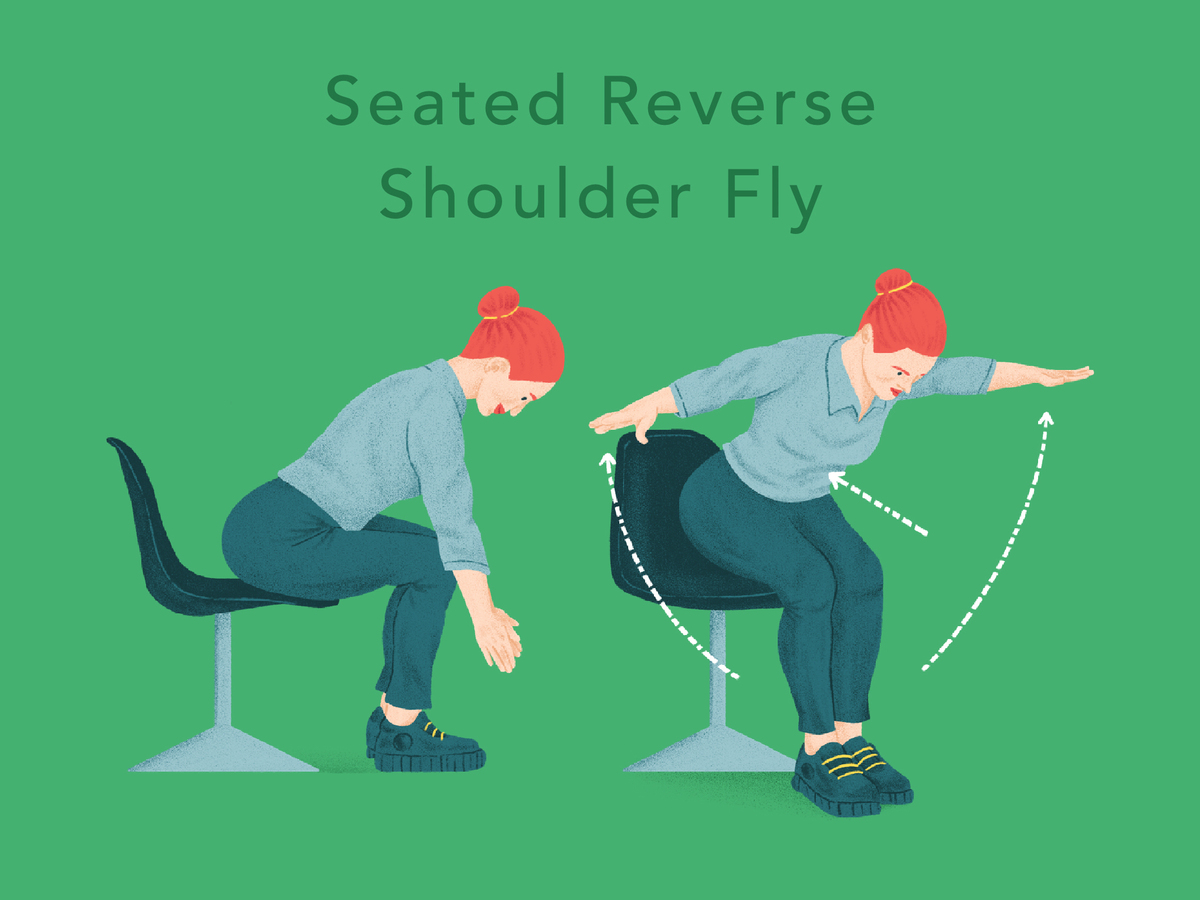
Seated Reverse Shoulder Fly: Sit on the edge of the chair and lean forward while keeping your lower back naturally arched. Your palms should be facing each other. Raise your arms straight out from your sides. Pause and then slowly return to the starting position. Repeat the exercise 15 times.
Cha Pornea for NPR
Many of the employees in the study, including office workers, used elastic resistance bands for 10-minute exercise breaks, three times a week. They did exercises like placing the bands between the hands, pulling the arms open, and squeezing the shoulders together. Employees could take breaks using the bands at their desk or gather with co-workers to exercise together.
Stretching resistance bands apart with your hands can counter the slouching, forward motion of the neck and shoulders when working at a computer. It can also help with muscle fatigue from sitting at a desk for long periods by strengthening back muscles, says Lars L. Andersen, a professor of musculoskeletal disorders at Denmark’s National Research Centre for the Working Environment and lead author of the study.
The study demonstrated that “active breaks are good for the body and the mind and help with pain,” says Andersen.
The NIH’s Langevin is a fan of using yoga stretches for movement snacks because they help to maintain the flexibility of connective tissue. Gentle movement from the practice can also encourage the body to relax and reduces the risk of aggravating back pain.
In July 2020, the NIH published a video of Langevin demonstrating some of the movements she recommends, including taking one arm in a large gentle circle, while stretching the neck in the opposite direction and then repeating the move in the opposite direction, and on the opposite side.
Even if you are feeling sore, gentle motion can be soothing. “For musculoskeletal pain in general, movement is a really good thing,” she says.
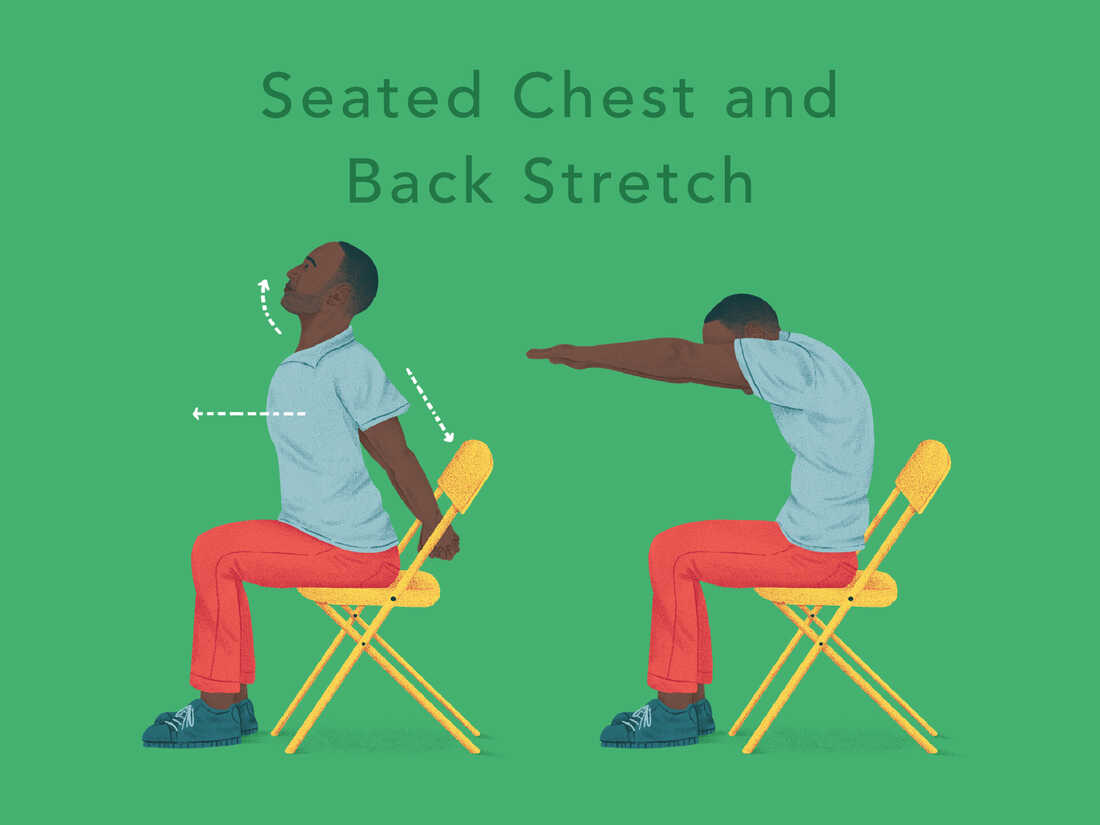
Seated Chest and Back Stretch: Clasp your hands behind your lower back. Push your chest outward, and raise your chin. Hold for 10-15 seconds, breathing deeply. Next, stretch your arms out straight in front of you, palms facing down. Lower your head in line with your arms, and round your back while looking down. Hold for 10-15 seconds, breathing deeply. Perform at least two sets.
Cha Pornea for NPR
hide caption
toggle caption
Cha Pornea for NPR

Seated Chest and Back Stretch: Clasp your hands behind your lower back. Push your chest outward, and raise your chin. Hold for 10-15 seconds, breathing deeply. Next, stretch your arms out straight in front of you, palms facing down. Lower your head in line with your arms, and round your back while looking down. Hold for 10-15 seconds, breathing deeply. Perform at least two sets.
Cha Pornea for NPR
The exercises and captions included are adapted from NASA’s DeskFit program, created by the NASA Headquarters Fitness Center team, Tanya Johnson, Marceleus Venable, and Kimber Williams.
Bara Vaida is a Washington, D.C.-based freelance health care journalist and a yoga teacher.

